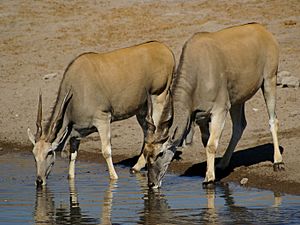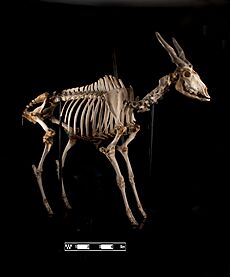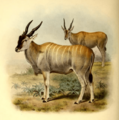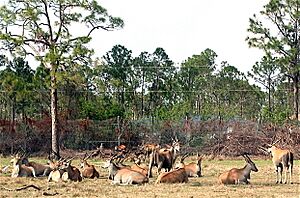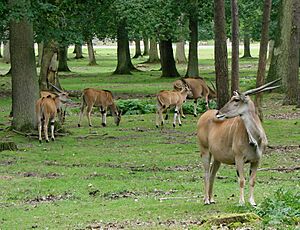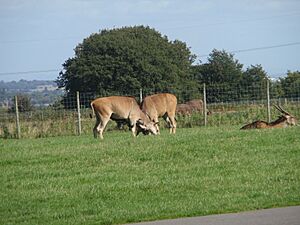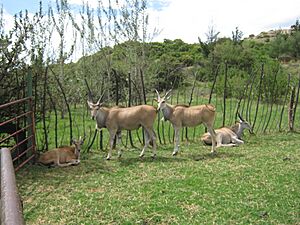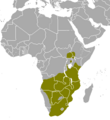Common eland facts for kids
Quick facts for kids Common eland |
|
|---|---|
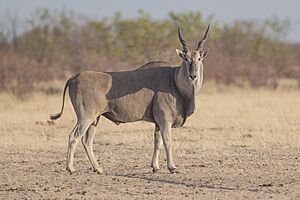 |
|
| Conservation status | |
| Scientific classification | |
| Subspecies | |
|
|
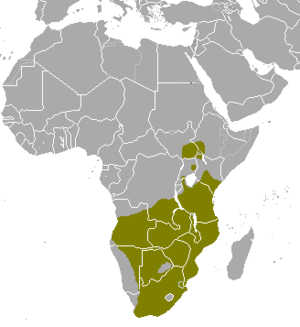 |
|
| Common eland range | |
| Synonyms | |
|
Species synonymy
Tragelaphus oryx (Pallas, 1766)
Taurotragus alces (Oken, 1816) Taurotragus canna (C. H. Smith, 1827) Taurotragus barbatus (Kerr, 1792) Taurotragus oreas (Pallas, 1777) Taurotragus typicus Selous, 1899 Taurotragus livingstonei (P. L. Sclater, 1864) Taurotragus billingae Kershaw, 1923 Taurotragus kaufmanni (Matschie, 1912) Taurotragus niediecki (Matschie, 1913) Taurotragus selousi Lydekker, 1910 Taurotragus triangularis (Günther, 1889) Taurotragus pattersonianus Lydekker, 1906 |
The common eland (Taurotragus oryx) is a very large antelope found in East and Southern Africa. It lives in wide-open savannah and plains. An adult male can stand about 1.6 meters (5.2 feet) tall at the shoulder. Females are a bit shorter. Males can weigh up to 942 kilograms (2,077 pounds), while females are lighter, around 340–445 kilograms (750–981 pounds).
The common eland is the second-largest antelope in the world. Only the giant eland is slightly bigger. A scientist named Peter Simon Pallas first described it in 1766.
Elands are mainly herbivores, meaning they eat plants. Their diet includes grasses and leaves. Common elands live in herds that can have up to 500 animals. They are not very territorial, meaning they don't strongly defend their living space. Elands like places with many different flowering plants, such as savannas, woodlands, and open grasslands. They avoid thick forests.
Elands use loud barks, body movements, and special smells to talk to each other. They also warn others about danger. People use common elands for leather and meat. They have even been domesticated in southern Africa. Eland milk has more fat than cow's milk and can stay fresh longer without special treatment.
Common elands live in many African countries, including Angola, Botswana, Kenya, South Africa, and Zimbabwe. They used to live in Burundi but are no longer found there. Even though their numbers are slowly going down, the common eland is listed as an animal of "least concern" by the International Union for Conservation of Nature. This means they are not currently in danger of disappearing.
Contents
What's in a Name? The Eland's Story
The scientific name for the common eland is Taurotragus oryx. This name comes from three Greek and Latin words. Tauros is Greek for "bull," and tragos is Greek for "male goat." This refers to the tuft of hair in the eland's ear, which looks a bit like a goat's beard. Oryx is a Latin and Greek word for "pickaxe," which describes the pointed horns of antelopes like the eland.
The name "eland" comes from the Afrikaans word for "elk" or "moose." When Dutch settlers arrived in South Africa, they saw this large animal and named it after the big, plant-eating moose they knew from Europe. In Dutch, they call it "eland antelope" to show it's different from the moose found in colder northern forests.
Eland's Look: Size, Coat, and Horns
Common elands are a type of antelope with spiral horns. Males and females look different. Females are smaller than males. Females weigh between 300 and 600 kilograms (660–1,320 pounds). They are about 2 to 2.8 meters (6.6–9.2 feet) long from nose to tail and stand 1.25 to 1.53 meters (4.1–5 feet) tall at the shoulder. Males are larger, weighing 400 to 942 kilograms (880–2,077 pounds). They are 2.4 to 3.45 meters (7.9–11.3 feet) long and stand 1.5 to 1.83 meters (4.9–6 feet) tall. Their tails are about 50 to 90 centimeters (20–35 inches) long.
Their fur color changes depending on where they live. Elands in the north have special markings like stripes on their bodies and legs. Elands in the south usually don't have these stripes. Their fur is smooth, except for a rough mane on their neck. Females have a tan coat. Males have darker coats that can look bluish-grey. Older males often become more grey. Males also have thick fur on their foreheads and a large flap of skin called a dewlap under their throats.
Both male and female elands have horns that twist in a spiral shape. These horns start as small bumps on newborn calves and grow quickly. Male horns are thicker and shorter than female horns. Male horns are 43 to 66 centimeters (17–26 inches) long, while female horns are 51 to 69 centimeters (20–27 inches) long. Males use their horns to fight other males during mating season. Females use their horns to protect their young from predators.
Elands are the slowest antelopes. They can run up to 40 kilometers per hour (25 mph) but get tired quickly. However, they can trot at 22 kilometers per hour (14 mph) for a long time. They can jump up to 2.5 meters (8.2 feet) high from a standing start if they get scared. Young elands can jump even higher, up to 3 meters (9.8 feet). Common elands usually live for 15 to 20 years. Some can live up to 25 years in zoos.
Eland herds make a loud clicking sound. Scientists think this sound happens when the two halves of their hooves spread apart under their weight and then snap back together when they lift their leg. This sound can travel far and might be a way for them to communicate.
Eland Family: Types of Common Elands
The common eland was first described in 1766 by a German scientist named Peter Simon Pallas. It belongs to a group of animals called Bovidae, which includes cattle and other antelopes.
Scientists recognize three main types, or subspecies, of common elands. They are:
- T. o. oryx (Cape eland): This type is found in Southern and southwestern Africa. Their fur is a yellowish-brown color, and adult elands of this type usually lose their stripes.
- T. o. livingstonii (Livingstone's eland): This type lives in central Africa. Livingstone's eland has brown fur and can have up to 12 stripes on its body.
- T. o. pattersonianus (East African eland or Patterson's eland): This type is found in East Africa. Like Livingstone's eland, its fur can also have up to 12 stripes. This type was named after John Henry Patterson, who wrote about them in his book The Man-eaters of Tsavo.
Where Elands Live: Their Home and Habitats
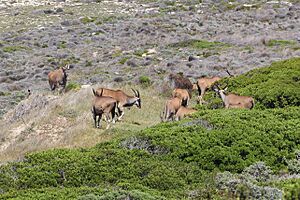
Common elands live on the open plains of Southern Africa and near the mountains of the great southern African plateau. They can be found as far north as Ethiopia and South Sudan, west into Angola and Namibia, and south to South Africa. However, there aren't as many elands in some parts of Africa because of poaching (illegal hunting) and human settlements growing.
Elands prefer to live in dry areas with many bushes. They often live in grasslands, woodlands, and even on mountaintops up to 4,572 meters (15,000 feet) high. Elands avoid thick forests, swamps, and deserts. The places where elands live usually have trees and shrubs like Acacia and Grewia, which they also eat.
Today, you can find elands in many national parks and wildlife reserves. Some famous ones include Nairobi National Park in Kenya, Serengeti National Park in Tanzania, Kruger National Park in South Africa, and Etosha National Park in Namibia.
Elands have a home range, which is the area they usually live in. For females and young elands, this can be a large area of 200–400 square kilometers (77–154 square miles). Males usually have smaller home ranges of about 50 square kilometers (19 square miles).
Eland Life: Daily Habits and Social Life
Common elands are nomadic, meaning they move around a lot. They are most active in the morning and evening. They eat during these cooler times and rest in the shade when it's hot. When it's cold, they stay in the sunlight. Elands are often seen in herds of up to 500 animals. Individual elands might stay with a herd for a few hours or several months.
Young elands and their mothers often form larger herds. Males might form smaller groups or wander alone. During mating season, especially in the rainy season, groups tend to form more often. In Southern Africa, common elands sometimes hang out with herds of zebras, roan antelopes, and oryxes.
Elands communicate using body language, sounds, and smells. For example, if male elands see a predator nearby, they will bark loudly. They trot back and forth to get the attention of the other elands until the whole herd knows about the danger. Their main predators include lions, African wild dogs, cheetahs, and spotted hyenas. Baby elands are more likely to be hunted than adult elands.
What Elands Eat
Common elands are herbivores. This means they eat plants. During the dry winter, they mostly browse, eating leaves from bushes and trees. But in the rainy season, when grasses are plentiful and full of nutrients, they switch to grazing. They need a diet high in protein from juicy leaves of flowering plants. However, they can eat lower-quality plants if better food isn't available. This includes herbs, trees, shrubs, grasses, seeds, and roots. Some grasses they eat are Setaria and Themeda. They also eat fruits from Securinega and Strychnos trees.
Elands get most of their water from the food they eat. But they will drink water if it's available. They can quickly change their eating habits based on the seasons and their surroundings. They also use their horns to break off branches that are too high to reach.
Staying Cool in the Heat
Common elands have special ways to deal with the hot temperatures where they live. They can sense heat on their skin and adjust how much they sweat to cool down. On sunny days, their skin stays cooler than their inside body temperature because they sweat more. This helps them feel cooler, even though their body temperature stays about the same. Elands can also save water by letting their body temperature rise a bit. When it gets very hot, they sweat and pant more. Their thin fur helps them release extra heat. The large flap of skin under their throat, called a dewlap, also helps them stay cool. It has a large surface area, which helps bigger elands cool down more easily.
Eland Families and Babies
Female elands can have babies when they are 15 to 36 months old. Males are ready to mate when they are 4 to 5 years old. Mating can happen at any time, but it's most common during the rainy season. In some places, like Zambia, babies are born in July and August. In other places, this is when mating happens.
Mating starts when elands gather in green, grassy plains. Males chase females to see if they are ready to mate. They also smell the female's urine. Usually, a female chooses the strongest and healthiest male to mate with. Sometimes, she runs away from males, which makes them even more interested. This can lead to fights between males, where they use their strong horns. A female will allow a male to mate after two to four hours. Males usually stay close to females during this time. A dominant male can mate with more than one female. Females are pregnant for nine months and give birth to only one calf at a time.
Male, female, and young elands form separate social groups. The male groups are the smallest. Members stay together and look for food or water. Female groups are much larger and cover bigger areas. They travel across grassy plains when it's wet and prefer bushy areas when it's dry. Females have a clear pecking order, or hierarchy.
A nursery group forms naturally when females give birth. About 24 hours after a calf is born, the mother and calf join this group. The calves start playing together and stay in the nursery group. The mother then returns to the female group. Calves leave the nursery group when they are at least two years old and join either a male or female group.
Elands and People: Conservation and Uses
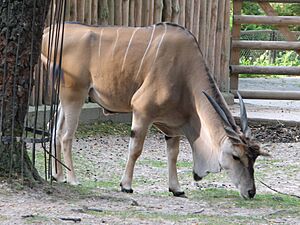
Common elands are not currently endangered. They are protected by laws in the United States and regulated by an international agreement called CITES. Scientists estimate there are about 136,000 common elands in the wild. Their numbers are stable or increasing in countries like Namibia, Botswana, and South Africa.
However, the number of elands is slowly going down in some areas. This is because their homes are being lost as human towns grow. Also, illegal hunting (poaching) for their meat is a problem. Elands are calm and don't move much, so they can be easy targets for hunters. The species disappeared from Eswatini and Zimbabwe but has been brought back.
About half of all common elands live in protected areas like national parks. Another 30% live on private land, especially in Namibia, Zimbabwe, and South Africa. This is because they are valued as animals for hunting trophies. Common elands have also been widely raised on farms in Zimbabwe and South Africa.
How Elands are Used
Sometimes, common elands are raised on farms or hunted for their meat. In some cases, they are even better to farm than cattle because they are better suited to the African climate. This has led some farmers in Southern Africa to switch from raising cattle to raising elands. Common elands are also shown on the coat of arms of Grootfontein, Namibia.
Raising Elands on Farms
Common elands have a gentle nature and have been successfully raised on farms for their meat and milk in South Africa and Russia. They don't need much water because their bodies are good at saving it. However, they need a lot of space to graze. They also need salt licks and extra food like corn, sorghum, melons, and beans, which can be expensive.
A female eland can produce up to 7 kilograms (15 pounds) of milk per day. This milk is richer in fat than cow's milk. The milk tastes good and can be stored for up to eight months if prepared correctly, much longer than cow's milk.
Keeping common elands on farms can be tricky. They can jump over fences as high as 3 meters (9.8 feet) or simply break through them with their strength. Sometimes, wild elands even break into farm enclosures to mix with the domesticated ones. Elands can have babies in captivity, but it's hard to keep the young calves alive. Sometimes, baby elands need to be separated from their mothers to make sure they stay healthy and get enough food. Raising elands requires care because even though they are usually calm, they can get scared easily and need a lot of space.
Images for kids



